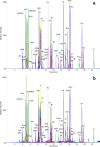A sensitive LC-MS/MS method for isomer separation and quantitative determination of 51 pyrrolizidine alkaloids and two tropane alkaloids in cow's milk
- PMID: 36183043
- PMCID: PMC9613554
- DOI: 10.1007/s00216-022-04344-5
A sensitive LC-MS/MS method for isomer separation and quantitative determination of 51 pyrrolizidine alkaloids and two tropane alkaloids in cow's milk
Erratum in
-
Correction to: A sensitive LC-MS/MS method for isomer separation and quantitative determination of 51 pyrrolizidine alkaloids and two tropane alkaloids in cow's milk.Anal Bioanal Chem. 2023 Jan;415(3):525. doi: 10.1007/s00216-022-04454-0. Anal Bioanal Chem. 2023. PMID: 36416897 Free PMC article. No abstract available.
Abstract
1,2-Unsaturated pyrrolizidine alkaloids (PA), their corresponding N-oxides (PANO), and tropane alkaloids (TA) are toxic secondary plant metabolites. Their possible transfer into the milk of dairy cows has been studied in feeding trials; however, only few data on the occurrence of these toxins in milk are available. In this study, the development of a sensitive analytical approach for the simultaneous detection and quantification of a broad range of 54 PA/PANO as well as of the TA atropine and scopolamine in milk of dairy cows is presented. The method optimisation focused on sensitivity and separation of PA/PANO isomers. Milk samples were extracted using liquid-liquid extraction with aqueous formic acid and n-hexane, followed by a cation-exchange solid-phase extraction for purification. Reversed phase liquid chromatography tandem mass spectrometry (LC-MS/MS) analysis was performed using alkaline solvent conditions. Validation proved low limits of detection and quantification of 0.005 to 0.054 µg/L and of 0.009 to 0.123 µg/L, respectively. For 51 of the 54 tested PA/PANO and both TA, the recovery rates ranged from 64 to 127% with repeatability (RSDr) values below 15% at concentration levels of 0.05 and 0.50 µg/L and below 8% at a concentration level of 3.00 µg/L. Only three PANO did not match the validation criteria and were therefore regarded as semiquantitative. The final method was applied to 15 milk samples obtained from milk vending stations at farms and from local marketers in Bavaria, Germany. In three of the milk samples, traces of PA were detected.
Keywords: Liquid chromatography tandem mass spectrometry; Method development; Milk; Pyrrolizidine alkaloids; Tropane alkaloids.
© 2022. The Author(s).
Conflict of interest statement
The authors declare no competing interests.
Figures



Similar articles
-
Pyrrolizidine alkaloids and tropane alkaloids in milk samples from individual dairy farms of the German federal states of Bavaria and Schleswig-Holstein.Food Addit Contam Part A Chem Anal Control Expo Risk Assess. 2024 Jun;41(6):629-647. doi: 10.1080/19440049.2024.2336054. Epub 2024 Apr 9. Food Addit Contam Part A Chem Anal Control Expo Risk Assess. 2024. PMID: 38592240
-
Development of a sensitive analytical method for determining 44 pyrrolizidine alkaloids in teas and herbal teas via LC-ESI-MS/MS.Anal Bioanal Chem. 2019 Nov;411(27):7233-7249. doi: 10.1007/s00216-019-02117-1. Epub 2019 Sep 11. Anal Bioanal Chem. 2019. PMID: 31511948
-
Simultaneous determination of pesticides, mycotoxins, tropane alkaloids, growth regulators, and pyrrolizidine alkaloids in oats and whole wheat grains after online clean-up via two-dimensional liquid chromatography tandem mass spectrometry.J Environ Sci Health B. 2019;54(2):98-111. doi: 10.1080/03601234.2018.1531662. Epub 2019 Jan 2. J Environ Sci Health B. 2019. PMID: 30600768
-
Comprehensive review of pyrrolizidine alkaloids in bee products: Occurrence, extraction, and analytical methods.Food Chem. 2025 Aug 15;483:144211. doi: 10.1016/j.foodchem.2025.144211. Epub 2025 Apr 6. Food Chem. 2025. PMID: 40239577 Review.
-
Extracting and Analyzing Pyrrolizidine Alkaloids in Medicinal Plants: A Review.Toxins (Basel). 2020 May 13;12(5):320. doi: 10.3390/toxins12050320. Toxins (Basel). 2020. PMID: 32413969 Free PMC article.
Cited by
-
Assessment of Toxic Pyrrolizidine and Tropane Alkaloids in Herbal Teas and Culinary Herbs Using LC-Q-ToF/MS.Foods. 2023 Sep 26;12(19):3572. doi: 10.3390/foods12193572. Foods. 2023. PMID: 37835225 Free PMC article.
-
Pyrrolizidine Alkaloids as Hazardous Toxins in Natural Products: Current Analytical Methods and Latest Legal Regulations.Molecules. 2024 Jul 10;29(14):3269. doi: 10.3390/molecules29143269. Molecules. 2024. PMID: 39064851 Free PMC article. Review.
-
A validated LC-MS/MS multi-method for the determination of 110 mycotoxins and plant toxins in cow milk and application to samples from Germany.Anal Bioanal Chem. 2025 Sep;417(22):5047-5059. doi: 10.1007/s00216-025-06024-6. Epub 2025 Aug 7. Anal Bioanal Chem. 2025. PMID: 40775119 Free PMC article.
-
Analysis of Pyrrolizidine Alkaloids in Stingless Bee Honey and Identification of a Botanical Source as Ageratum conyzoides.Toxins (Basel). 2024 Jan 12;16(1):40. doi: 10.3390/toxins16010040. Toxins (Basel). 2024. PMID: 38251258 Free PMC article.
-
Pyrrolizidine Alkaloid Extraction and Analysis: Recent Updates.Foods. 2022 Nov 30;11(23):3873. doi: 10.3390/foods11233873. Foods. 2022. PMID: 36496681 Free PMC article. Review.
References
-
- Mattocks AR. Chemistry and toxicology of pyrrolizidine alkaloids. Academic Press; 1986. 393 pp.
MeSH terms
Substances
Grants and funding
LinkOut - more resources
Full Text Sources

